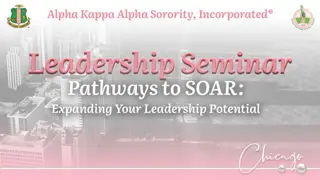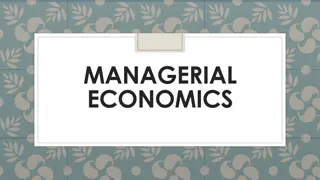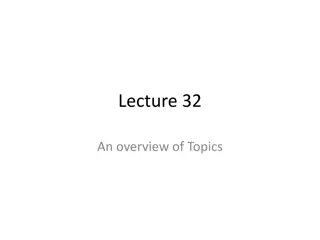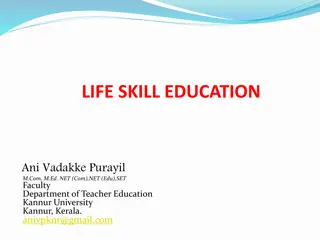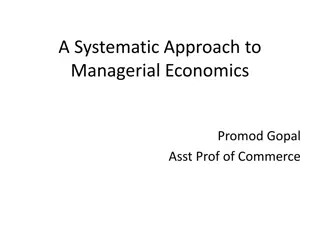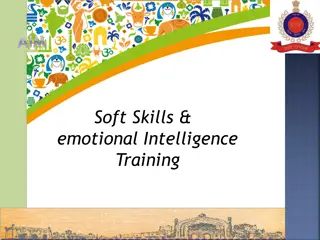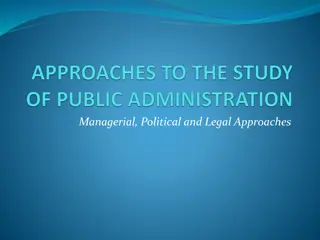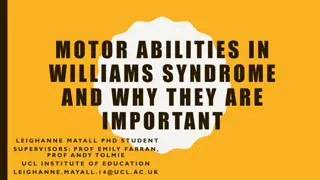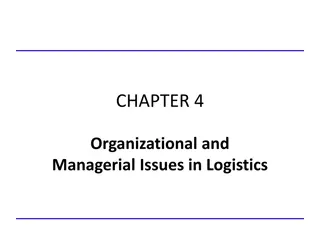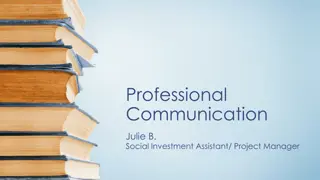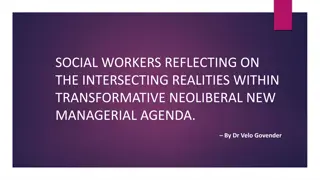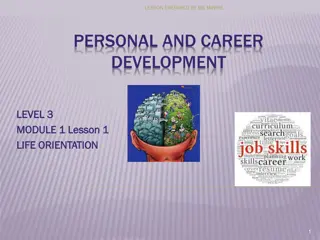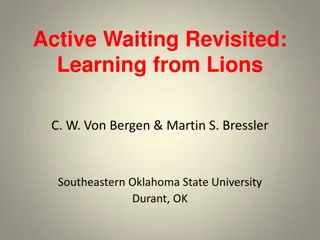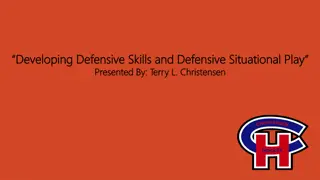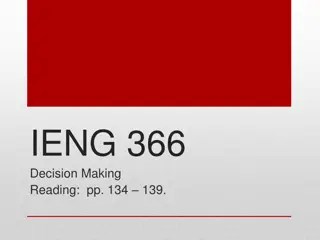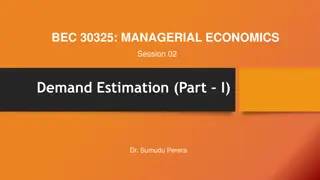Professional Communication Skills: Enhancing Managerial Communication Abilities
Professional Communication Skills course focuses on improving writing, presentation, and interpersonal communication skills for future managers. Students will learn best practices derived from research and experience, with a workshop format emphasizing discussion and in-class exercises. The aim is to equip students with the awareness, skills, and knowledge needed to navigate communicative challenges in the global business world. Course outcomes include developing interpersonal and leadership skills, enhancing verbal and written presentation skills, and understanding workplace etiquette and attire.
Download Presentation

Please find below an Image/Link to download the presentation.
The content on the website is provided AS IS for your information and personal use only. It may not be sold, licensed, or shared on other websites without obtaining consent from the author.If you encounter any issues during the download, it is possible that the publisher has removed the file from their server.
You are allowed to download the files provided on this website for personal or commercial use, subject to the condition that they are used lawfully. All files are the property of their respective owners.
The content on the website is provided AS IS for your information and personal use only. It may not be sold, licensed, or shared on other websites without obtaining consent from the author.
E N D
Presentation Transcript
------------------------------------------------------------------------------------------------------------------------------------------------------------------------------------------------------------------------------------------------------------ Academic Year : 2020-21 Name of the Subject : Professional Communication Skills Prescribed Textbook : Meenakshi Raman and Prakash Singh, Business Communication, Oxford Seema Gupta, Correct Manners& Etiquette, Pustak Mahal Nature of the Subject : Common Paper ------------------------------------------------------------------------------------------------------------------------------- Professional Communication is intended to help students to think strategically about communication and aid students in improving writing, presentation, and interpersonal communication skills as a future manager. We will look at a set of "best practices" or guidelines that have been derived from both research and experience, give you the opportunity to put those guidelines into practice, and provide you with feedback on your work to help you strengthen your abilities. We will be using a workshop format that will rely heavily on discussion and in-class exercises. It aims to equip you with the awareness, skills, and knowledge necessary to master the communicative challenges you will face in today s global business world.
Course Instructors Dr.P.Ramya MBA, Ph.D Assistant Professor Mr.V.Hari Krishna B.sc(Comp), MBA Assistant Professor Ms. M.Sunita BA(Eng Litr), MBA Assistant Professor
COURSE AIM This course is intended to develop knowledge and skills necessary for effective communication advantageous within the workplace and professional environment. The primary objectives of the course are to have the students learn the following: Students will be able to demonstrate interpersonal skills for working in a dynamic and diverse world, including in a team environment. leadership knowledge and skills based upon communication principles, Develop verbal and written presentation skills COURSE OUTCOMES Students will be able to send and interpret verbal and nonverbal messages with accuracy and effectiveness. Develop communication and critical thinking skills necessary for securing a job and succeeding in the diverse, ever-changing workplace. Demonstrate knowledge of leadership and problem solving communication in teams. Create and deliver a business presentation ,also anticipate and respond to questions during a presentation. Plan and create proper business documents. Impart awareness and knowledge of professional attire demonstrate knowledge of workplace and professional etiquette.
Unit-I Concepts of Communication Introduction: Definition and Process of Communication - Forms of verbal and Non-verbal Communication Barriers of Communication: Communication barriers and overcoming communication barriers - guidelines for effective Communication. Business Writing: Direct and Indirect approaches to Business Writing - Five Main Stages of Writing Business Messages. Objective It explains the process and forms of communication. It gives overview about different approaches to business messages Outcome To make the students learn the process of communication, direct and indirect approaches to business messages and five main stages of writing business messages. Overview To provide an outline to effective Organizational Communication. To underline the barriers of Business communication. To impart the correct practices of the strategies of Effective professional Communication To Understand the role of communication in personal & professional success. Develop awareness of appropriate communication strategies. Students will be able to communicate effectively orally and in writing. Students will develop knowledge, skills, and judgment around human communication that facilitate their ability to work collaboratively with others. Analyze a variety of communication acts.
Unit-II Written Business Communication External Communication: The Seven Cs of Letter writing, Kinds of Business Letters,Business Reports and Proposals, Purpose of Business Reports. Internal Communication: Format and Principles of writing Memos, Notices, General Warning, Minutes of meetings, Cautions and Oral Instructions Objective The objective is to develop students written expression of thought and provide learners opportunities to explore ideas and to build connections between content areas. Students will be able to communicate effectively through the written word for a wide variety of purposes and audiences The overview is to use the process of writing to enhance intellectual discovery and unravel complexities of thought. Gather ideas, define and narrow topics, evaluate, select, and order material to write organized paragraphs, essays, reports, emails and business or personal letters. Adjust the content and style of your writing to purpose, audience, and situation. Develop letter-writing strategies. Produce business writing (including reports and memos, emails, and letters) with minimum preparation time. Write a report that includes analysis and offers recommendations. Write, revise, and edit work to improve content organization, word choice, phrasing, sentence and paragraph structure, spelling, and punctuation. Recognize and correct clich s, jargon, slang, poor tone, and wordiness in sentences. Use computer spelling checkers and grammar checkers appropriately and effectively. Outcome Overview
Unit-III Oral Communication Public Speaking: Types of public speaking - importance of public speaking. Power Point Presentation: Planning the presentation - Delivering the presentation - Developing & displaying visual aids - Handling questions from the audience. Listening: Definition - Types of Listening skills - Features of a good Listener - Causes and effects of poor Listening Objective To explore the students for public speaking, presentation and listening skills Outcome To make the students understand the significance of speaking skills, listening skills and presentation skills in different contexts. It analyses the types and importance of public speaking skills. Analyze an audience and tailor the delivery accordingly Design presentations for maximum impact Expand on key points to ensure clarity Inspect the proposed venue Master techniques to overcome nervousness and present with confidence Practice techniques that ensure clear, concise and effective wording is used It elaborates the various power point presentation techniques. Deliver a polished, professional and credible speech Handle questions and comments effectively It explains types, features, causes and effects of poor listening skills Overview
Unit-IV Behavioral Techniques Body Language: Facial expressions - Body posture Gestures - Eye movement Touch and the use of personal space. Business attire and Grooming: Different types of attire - Guidelines for business attire. Objective To teach the usefulness of body language, business attire and grooming Outcome Students can inculcate correct body language and obtain professional attire Overview To understand role of various types of body language in the professional context. Learn how to translate gestures into words and Learn how to avoid common body language mistakes. Understand the difference between open & closed body language Gain insight into the differences in body language between genders Learn the role facial expressions play in body language Learn how to use body language to strengthen your negotiation Learn how to match words with movement to instill trust Explain how having a professional appearance can boost the chance for workplace success Understand the difference between appropriate and inappropriate business attire Distinguish crucial grooming considerations that are par of a professional Presence. Recognize the role of accessories in maintaining a professional appearance Develop a personal action plan to improve professional image.
Unit-V ETIQUETTES Etiquettes: Greeting Etiquette - Corporate Etiquette - Telephone Etiquette - E-mail Etiquette - Meeting Etiquette - Netiquette - Personal Etiquette - Social Etiquette - Dining Etiquette Objective Students can learn various types of etiquettes in order to succeed in the professional life. Outcome Students will be able to inculcate various etiquette namely corporate etiquette, social etiquette, netiquette meeting etiquette, personal etiquette etc. Define etiquette and understand how it is valuable to companies and other organizations. Understand how to make effective introductions and Use a business card effectively. Implement techniques to minimize nervousness in social situations. Understand why business etiquette matters and how to improve business etiquette culture Understand the three components of business etiquette - appearance, communication, and behavior Understand the intricacies of introducing people in business contexts and how to remember people s names Know the right way to behave online in a business context Explore the do's and don'ts of email etiquette Explore the business etiquette of different cultures and countries Know how to behave in business social contexts Understand the etiquette of how to deal with ethical dilemmas, personal issues, and difficult people Overview


